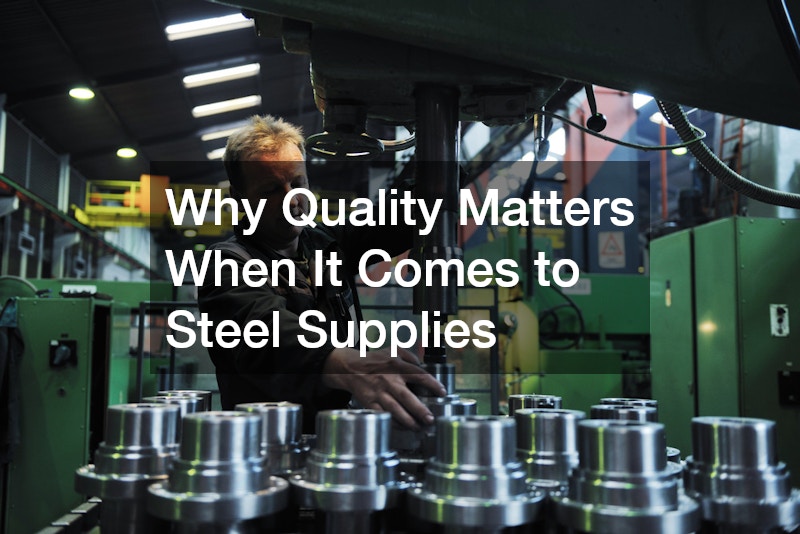
Whether you’re working on a residential build, commercial structure or custom fabrication project, the quality of your steel supplies can make or break the outcome. Steel is one of the most widely used materials in construction and manufacturing, prized for its strength, durability and versatility.
But not all steel is created equal. Relying on poor-quality supplies can lead to costly repairs, compromised safety and project delays—risks no builder or contractor can afford to take.
Choosing quality steel from a trusted supplier ensures that the material you’re working with meets Australian standards, performs well under pressure and lasts for decades. From structural integrity to cost-efficiency over time, there are many reasons to prioritise quality when sourcing steel supplies for any kind of project.
Structural Strength and Safety
One of the biggest reasons quality matters in steel supplies is safety. High-grade steel is designed to withstand pressure, stress and harsh environmental conditions. Whether it’s bearing the weight of a building or supporting infrastructure like bridges and warehouses, steel must perform reliably without bending, breaking or corroding prematurely.
Inferior or substandard steel can compromise a structure’s overall strength, creating hidden vulnerabilities that may not show up until it’s too late. In extreme cases, this can lead to structural failure, endangering lives and resulting in serious financial and legal consequences.
Steel that meets or exceeds Australian Standards (such as AS/NZS 3679 and AS/NZS 1163) has been rigorously tested for strength, consistency and durability. Choosing products that meet these standards gives builders and engineers peace of mind, knowing the material will do its job for the long haul. When steel is sourced from unreliable suppliers or imported without proper certification, there’s no guarantee of performance, and that’s a risk few professionals are willing to take.
Longevity and Low Maintenance
Quality steel supplies don’t just deliver strength—they also deliver longevity. When steel is properly treated and manufactured, it resists rust, corrosion and weathering much more effectively than cheaper alternatives. This is especially important in Australia, where building materials are often exposed to harsh sun, salt air and heavy rainfall.
Good-quality steel typically requires less maintenance over its lifetime, reducing the need for repairs and replacements. This translates into cost savings down the line, particularly for commercial and industrial projects that depend on long-term performance.
For example, galvanised or powder-coated steel may cost a little more upfront, but it provides excellent resistance to moisture and environmental degradation. Over the years, that investment pays off by avoiding early rust damage, repainting or reinforcement.
When clients see that a builder or fabricator is using reliable steel supplies, it can boost their confidence in the finished result. They know the project will not only look good on completion but also hold up under years of use and exposure to the elements.
Project Efficiency and Workability
Another advantage of choosing high-quality steel is workability. Premium-grade steel is easier to cut, weld and fabricate without unexpected issues like splitting, brittleness or deformation. When steel behaves as expected, it helps the entire construction or manufacturing process run more smoothly.
Time is money in any project, and delays caused by faulty materials can throw off timelines and inflate labour costs. Imagine having to stop production because a batch of steel has inconsistencies or fails stress testing—it’s not just frustrating, it can be expensive.
Reputable steel suppliers often provide added services like custom cutting, bending or delivery scheduling, which helps tradespeople streamline their workflow. When the material arrives on time and in good condition, it supports productivity and keeps teams moving forward without costly interruptions.
Inconsistent or low-grade steel can create unexpected hurdles, from difficulty during welding to alignment issues that affect how components fit together. All of this can be avoided by sticking with high-quality steel supplies from reputable sources.
Value Beyond the Price Tag
It’s easy to focus on price when sourcing materials, especially when working within a tight budget. But when it comes to steel, the cheapest option isn’t always the smartest. Lower-cost steel may appear attractive at first, but hidden costs often appear in the form of replacements, additional labour and decreased performance over time.
On the other hand, quality steel may carry a higher upfront cost but saves money and hassle in the long run. It also tends to hold its value better if the structure or product is ever sold. Clients and stakeholders are increasingly looking for quality materials as part of a broader focus on sustainability, safety and long-term value.
When comparing suppliers, it’s worth asking questions about origin, certifications, quality control and service support. The best suppliers are transparent about their processes and willing to stand behind their products. Building strong relationships with trusted providers means you’re more likely to get consistent quality and dependable service for future projects, too.
The Bottom Line
When it comes to construction and fabrication, steel supplies are one area where quality should never be compromised. Reliable steel provides strength, safety and durability, which form the foundation of any successful build. It also offers better performance, easier handling and fewer maintenance issues—saving time and money over the life of a project.
Whether you’re sourcing steel for a small job or a major development, the smart move is to partner with a supplier that values quality as much as you do. By making that choice early on, you’re investing in materials that will deliver real value well into the future.

